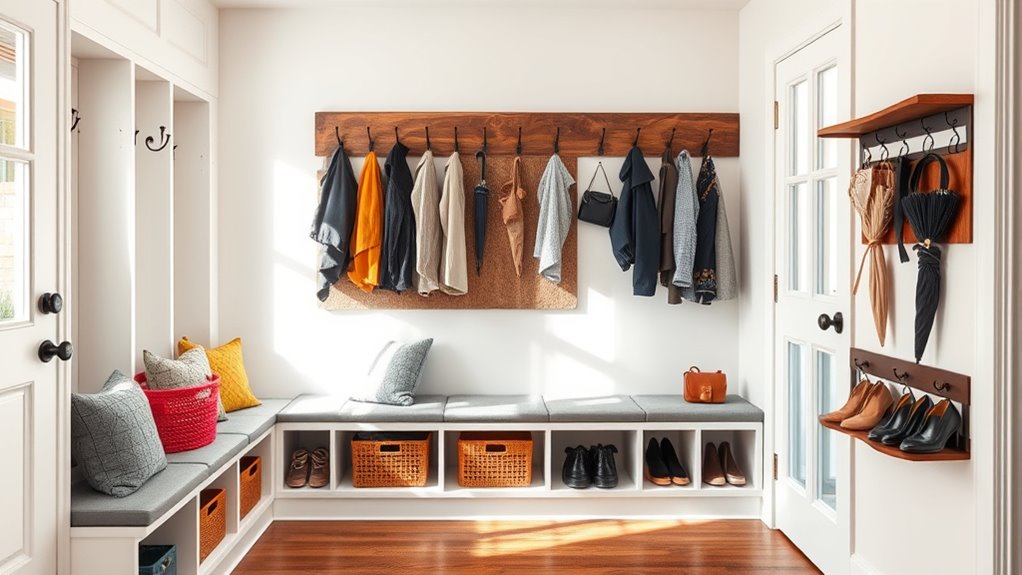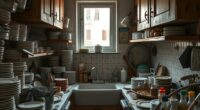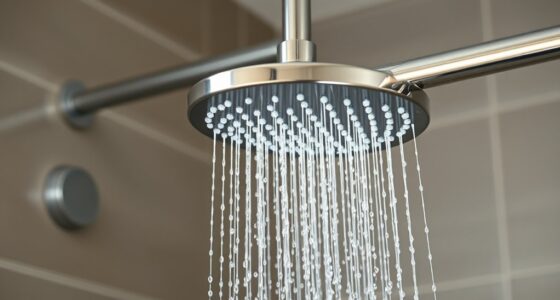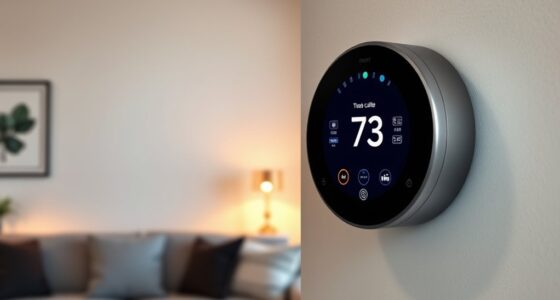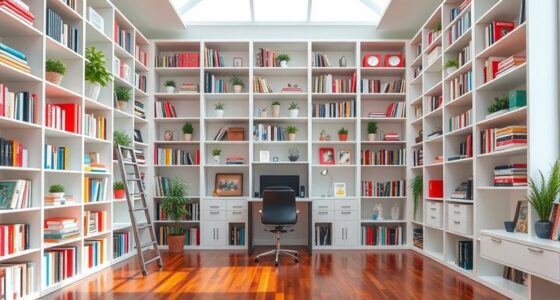To create a mudroom that organizes your life, start by evaluating your space and your needs. Choose durable storage solutions like solid wood or metal with adjustable shelves and waterproof finishes. Add seating, hooks, and labeled baskets to keep small items orderly. Incorporate personal touches such as photos or artwork for warmth. Regularly maintain and reorganize to keep everything functional and clutter-free. Want tips on perfecting each step? Keep exploring for all the details.
Key Takeaways
- Assess your space and plan zones with built-in shelves, hooks, and benches for efficient storage and traffic flow.
- Choose durable, moisture-resistant materials and hardware to ensure longevity in high-traffic areas.
- Incorporate seating with hidden storage and surfaces for convenience and added organization.
- Maximize vertical space with wall-mounted storage solutions and adjustable shelving for flexibility.
- Label baskets, hooks, and zones clearly to maintain order and facilitate easy item retrieval.
Assess Your Needs and Space
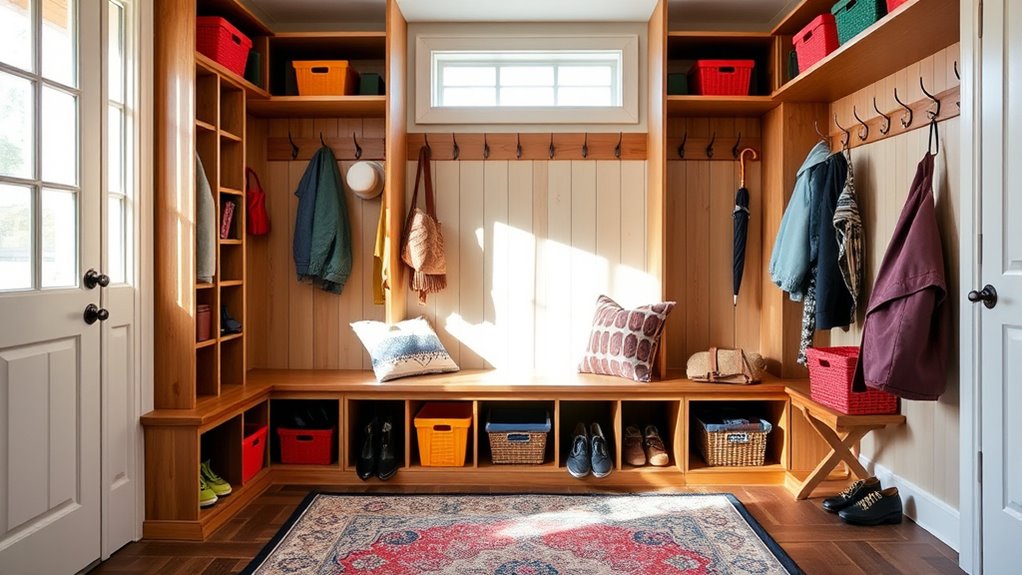
How do you determine the best layout for your mudroom? Start by evaluating the available space in your entryway, garage, or closet. Measure the dimensions carefully to ensure your storage solutions fit comfortably without obstructing movement. Think about the items you need to store—shoes, coats, backpacks, outdoor gear—and consider how to organize them efficiently. Assess your daily routines to identify when and where family members need quick access to essentials like keys, mail, or charging stations. Pay attention to traffic flow, placing key storage elements where they’ll be most accessible and useful. By understanding your space and specific needs, you can create a functional, well-organized entryway that keeps everything tidy and within reach. Incorporating interior design principles can also help you select lighting and display options that enhance visibility and usability. Additionally, considering storage solutions that optimize space can make a significant difference in maintaining an organized mudroom.
Choose Durable and Functional Storage Solutions
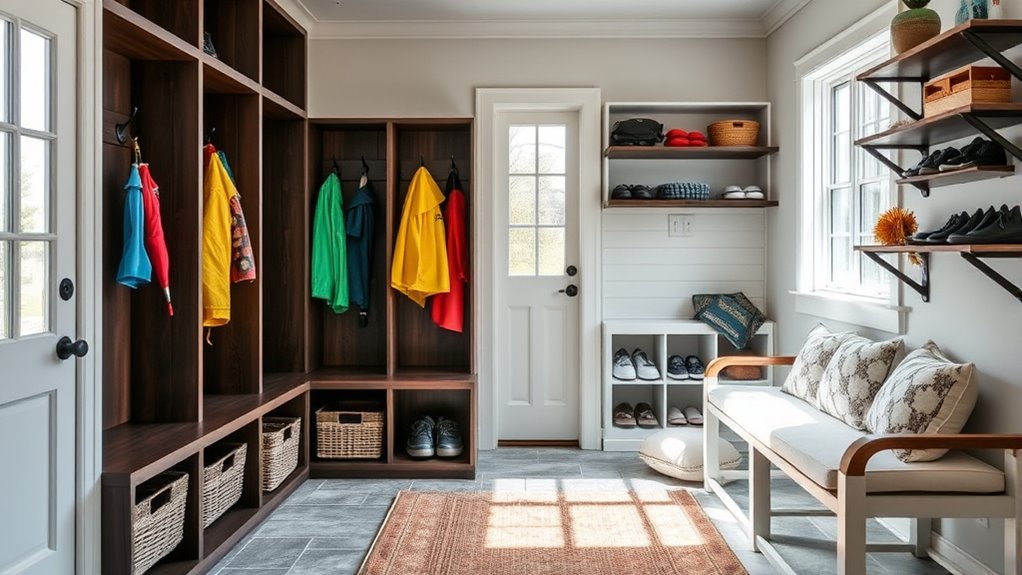
Selecting the right storage solutions for your mudroom is essential to guarantee they withstand daily use and outdoor conditions. Opt for heavy-duty materials like solid wood, metal, or high-impact plastic to ensure longevity. Incorporate adjustable shelving and pull-out drawers to adapt to changing needs and maximize space. Use moisture-resistant finishes and waterproof sealants to protect storage units from humidity and outdoor elements. Choose pieces with sturdy hardware, reinforced hinges, and heavy-duty handles to endure frequent use. Prioritize functional features such as built-in hooks, cubbies, and boot trays designed for durability. When selecting storage options, consider durable materials that are known for their toughness and resistance to outdoor wear, which can inspire the durability needed for your mudroom. Additionally, selecting self-watering plant pots made from durable materials can help keep your indoor greenery thriving in a space prone to moisture. Incorporate weather-resistant materials to further enhance the longevity of your storage solutions. Here’s a visual of durable options:
| Storage Solution | Material & Features |
|---|---|
| Wall-mounted hooks | Reinforced hardware, moisture-resistant |
| Cubbies & bins | Heavy-duty plastic, adjustable shelves |
| Shoe racks | Metal or waterproof-treated wood |
| Boot trays | Waterproof, durable plastic |
| Overhead cabinets | Solid wood, moisture-resistant finish |
Incorporate Seating and Surface Areas
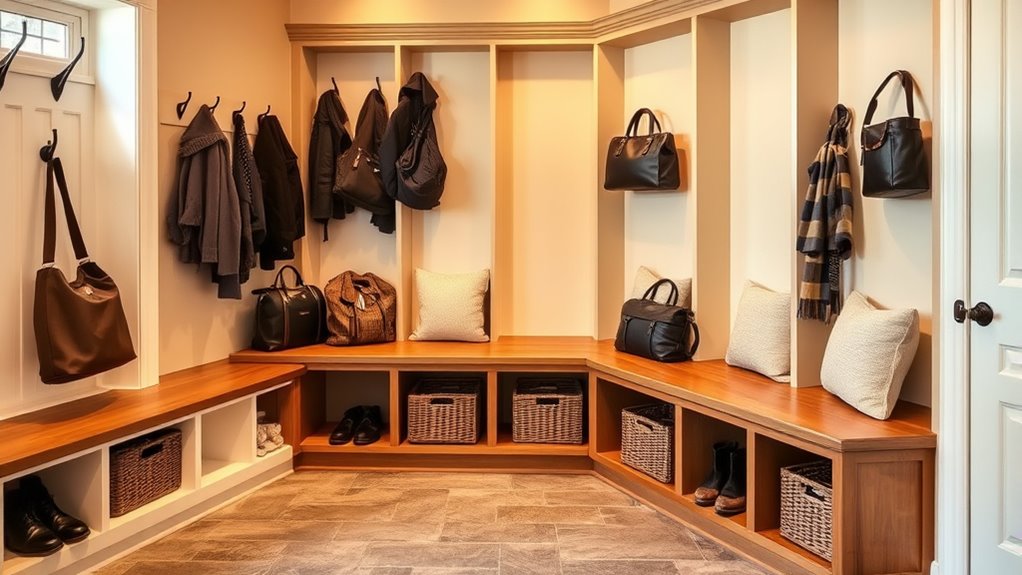
Incorporating seating and surface areas into your mudroom helps create a practical and inviting space. A sturdy bench or chair near the entry provides a convenient spot to put on or take off shoes, reducing clutter and boosting comfort. Opt for built-in or freestanding mudroom seating that matches your decor style and fits your space for a cohesive look. Choose a bench with hidden or under-seat storage to maximize functionality by discreetly storing shoes, hats, or gloves. Adding a small table or countertop adjacent to the seating offers a surface area to hold keys, mail, or small accessories for quick access. Guarantee the seating is durable, easy to clean, and positioned for smooth traffic flow to streamline your daily routines and keep your entryway storage organized. Incorporating innovative materials like decorative containers can also add a touch of personality and greenery to your mudroom, enhancing its aesthetic appeal. Leveraging creative practice in your design process can inspire unique and personalized solutions. Utilizing sustainable building practices can further improve the durability and eco-friendliness of your mudroom design.
Organize Small Items With Baskets and Hooks
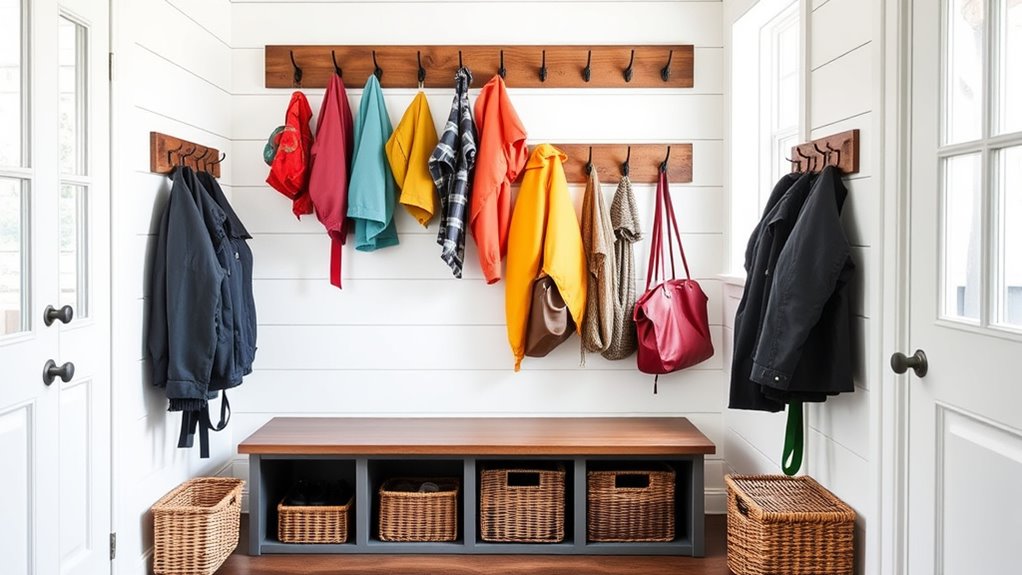
Using baskets and hooks helps you make the most of your vertical space and keeps small items organized. Label each basket and hook clearly so everyone knows where things belong, reducing clutter. Group similar items together to make finding what you need quick and easy. Additionally, incorporating storage solutions designed specifically for your space can further enhance organization and accessibility. Practicing mindfulness about your organization habits can also support emotional regulation and create a more calming entryway. Embracing leadership skills in organizing routines can encourage household members to maintain order more effectively.
Maximize Vertical Space
Have you considered how vertical storage can transform your mudroom? By using hooks on the wall at different heights, you maximize space for coats, hats, and bags without cluttering the floor. Open shelving with baskets or bins helps organize small items like gloves, scarves, and keys efficiently. Adjustable shelves allow you to customize storage to fit various items, keeping everything accessible. Vertical storage solutions like hanging organizers or pocket panels create compartments for small essentials, freeing up surface area. Additionally, regular inspections can ensure your storage solutions remain functional and safe over time. Incorporating rustic materials can enhance the farmhouse aesthetic while maintaining organization. Here’s a quick overview:
| Storage Type | Best For | Benefits |
|---|---|---|
| Hooks on the wall | Coats, bags, hats | Saves floor space |
| Open shelving | Small accessories, baskets | Easy access and organization |
| Adjustable shelves | Variable item sizes | Flexible and customizable |
Use Clear Labeling
Clear labeling is essential for keeping your mudroom organized and making items easy to find. Labels on baskets, bins, and hooks help you quickly identify the contents, saving time and reducing clutter. Use large, legible fonts or icons to enhance visibility, especially for children or guests unfamiliar with your organization system. Label small items like gloves, hats, and scarves to prevent clutter from spreading and ensure each item has a designated spot. Incorporate color-coded labels to streamline identification and improve visual organization. Regularly update your labels as storage needs change to maintain clarity and functionality. Additionally, using labels effectively helps maintain your system when replacing or adding new storage solutions. Clear labels create a seamless system that enhances overall organization, making your mudroom a practical space for everyday life. Emphasizing consistent labeling can further improve the efficiency of your organization system, ensuring everything stays in its designated place. Using labels also supports visual organization, which can significantly reduce the time spent searching for items. Incorporating ergonomic principles into your labeling system can make it more accessible and user-friendly for all household members. For example, considering user accessibility ensures that labels are easy to read and reach for everyone.
Group Similar Items
Grouping similar small items with baskets and hooks keeps your mudroom tidy and makes everything easier to find. Use small baskets or bins to categorize accessories like gloves, hats, and scarves, creating organized storage that saves time. Install hooks at varying heights to hang keys, lanyards, and small bags, keeping surfaces clear and items accessible. Clearly label baskets and hooks so family members can quickly identify where items belong, maintaining order. Designate zones for different groups of items, such as pet supplies or outdoor gear, to reduce clutter. Maximize vertical space by mounting wall baskets and hooks, making efficient use of limited areas. This approach helps you group similar items, optimize vertical space, and keep your mudroom neat and functional.
Add Personal Touches and Decorative Elements
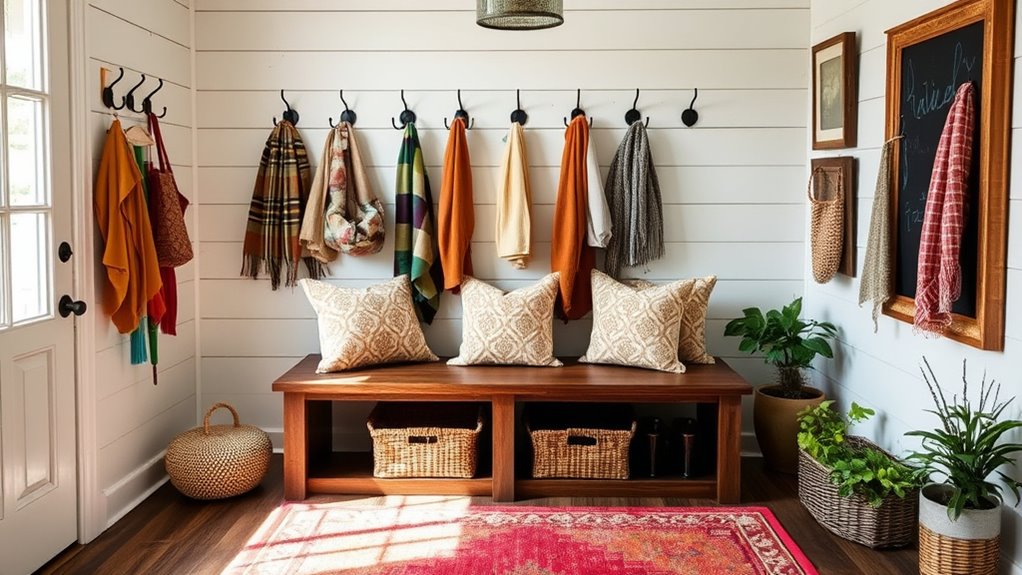
Adding personal touches and decorative elements transforms your mudroom into a welcoming and unique space. You can showcase family photos, artwork, or vintage signs to infuse warmth and personality. Incorporate themed accessories like French country accents or rustic motifs to reflect your style and create a cohesive look. Use colorful or patterned cushions, rugs, and baskets that match your decor theme to add visual interest and comfort. Hang meaningful or nostalgic items, such as heirloom coats or treasured souvenirs, to make the space feel more inviting. Decorative lighting fixtures like charming sconces or pendant lights not only enhance the ambiance but also provide functional illumination. These personal touches turn your mudroom into a space that’s both functional and full of character.
Maintain and Adjust Your Mudroom Organization
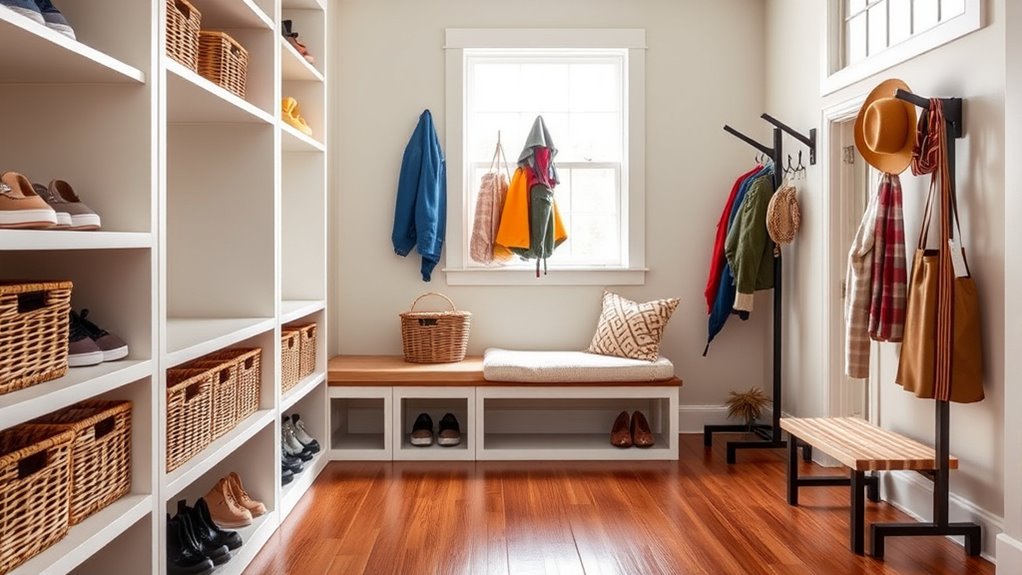
To keep your mudroom organized, make a habit of regularly decluttering and removing items you no longer need. Adjust your storage setups seasonally to accommodate changing needs and keep everything accessible. Remember to stay flexible with your systems, so they adapt as your family’s routines evolve.
Regular Decluttering Routines
Maintaining an organized mudroom requires consistent effort, so establishing a weekly routine is essential. Your decluttering routine helps keep clutter at bay and ensures your organization systems stay effective. Regularly, take a few minutes to sort through shoes, coats, and accessories, removing items that are unused or outgrown. Clean storage solutions by wiping down shelves and bins to prevent dust buildup. Reassess your storage solutions every few months to adapt to your family’s changing needs, swapping out or adding containers as necessary. Implement a quick daily 5-minute tidy-up, hanging coats and returning shoes to their designated spots. Keep a decluttering checklist or set reminders to evaluate and reorganize periodically, ensuring your mudroom remains functional and clutter-free.
Seasonal Reorganization Tips
As seasons change, your mudroom needs adjustments to stay organized and functional. Begin with seasonal decluttering by removing out-of-season clothing, shoes, and accessories to free space and reduce clutter. Update your storage solutions by adding or removing bins, hooks, and trays to accommodate seasonal gear like snow shovels or beach towels. Use labels with clear seasonal indicators on containers to streamline access and make reorganization easier each year. Regularly reassess your system to identify underused items and eliminate unnecessary clutter, keeping your mudroom efficient. Incorporate adjustable shelves or modular cubbies to easily adapt your layout as seasons shift. These simple steps ensure your mudroom remains a practical, organized space that evolves with your needs.
Keep Systems Flexible
Keeping your mudroom systems flexible guarantees they remain functional as your family’s needs change. Regularly assess your setup to spot what’s working and what needs adjusting, ensuring it adapts to evolving routines. Incorporate adjustable shelving, hooks, and modular storage to reconfigure spaces easily. Use labeled bins and baskets that can be added, removed, or reorganized without hassle, maintaining order. Prioritize versatile furniture like benches with hidden storage or open cubbies that can accommodate different items over time. Schedule periodic reviews to fine-tune your organization and keep the flow smooth. Flexibility guarantees your mudroom stays useful and clutter-free, no matter how your family’s habits shift. Staying adaptable keeps your mudroom efficient and ready for whatever comes next.
Frequently Asked Questions
How to Organize Your Mudroom?
To organize your mudroom, start by designating specific zones for shoes, coats, and accessories. Use wall-mounted hooks, cubbies, and labeled bins to maximize space and improve access. Regularly declutter by removing unused items, and keep everything tidy with a daily routine of tidying up and reassigning belongings. Incorporating functional furniture like benches with hidden storage helps maintain order, making your mudroom efficient and clutter-free.
How Do You Make a Mudroom Functional?
You might think a mudroom can’t be both stylish and functional, but it absolutely can. Start by adding designated zones with hooks, cubbies, and shelves to keep things tidy. Install a sturdy bench with storage, and use clear containers for small items. Make sure each family member has their own space, and choose good lighting to boost usability. With these steps, your mudroom will work seamlessly and look inviting.
How Much Would It Cost to Build a Mudroom?
The cost to build a mudroom varies based on size and materials, ranging from under $1,500 for DIY projects to $20,000 or more for high-end custom designs. If you hire professionals, expect to pay for materials, labor, and possible structural work. Budget accordingly, considering cabinetry, flooring, lighting, and any plumbing or electrical updates. Planning ahead helps you create a functional mudroom without overspending.
Does a Mudroom Add Value to a House?
Yes, a mudroom adds value to your house. It boosts your home’s resale value by up to 10%, making it more appealing to buyers. A well-designed mudroom enhances functionality, curb appeal, and daily convenience. It also helps safeguard your interior flooring and furniture from dirt and moisture. Investing in a mudroom is a smart way to increase your home’s marketability and ensure long-term maintenance, ultimately benefiting your property’s worth.
Conclusion
A well-organized mudroom keeps chaos at bay, but it’s also a reflection of your personality. While sturdy shelves and hooks bring order, personal touches like photos or plants add warmth. Balancing functionality with style transforms a cluttered space into a welcoming entryway. Remember, maintaining this harmony requires regular tweaks. In the end, your mudroom isn’t just a storage spot—it’s a simple sanctuary that welcomes you home, chaos and calm perfectly in balance.
